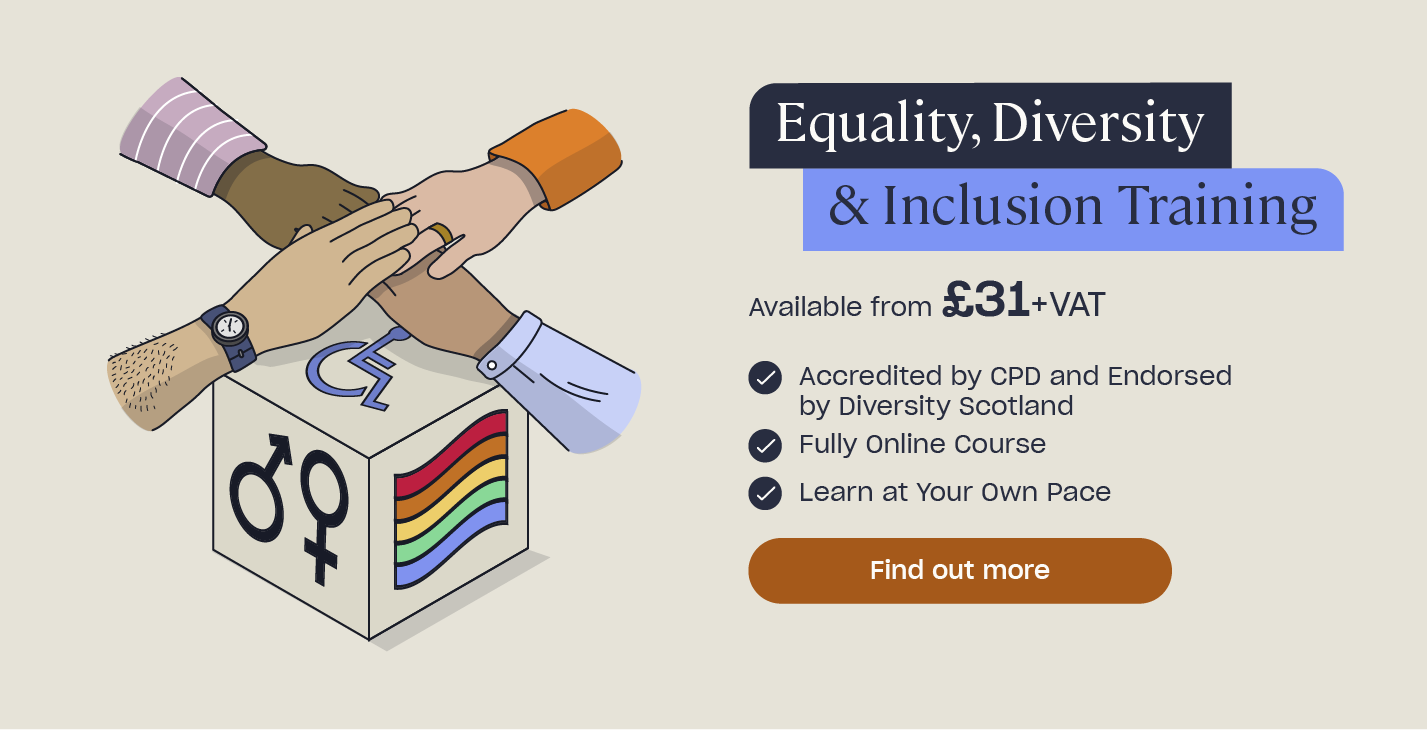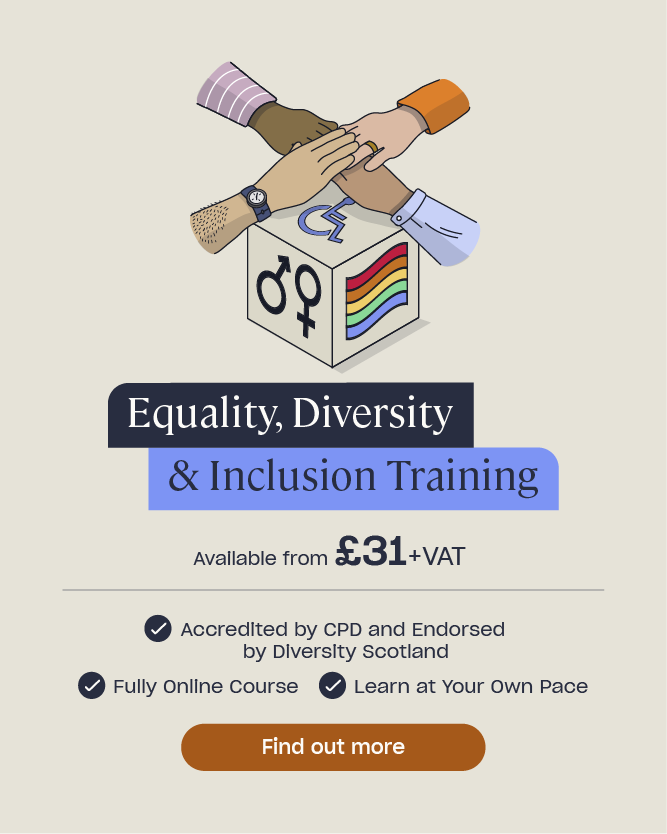Intersectionality in the Workplace
For employers, managers, HR professionals and workplace leaders, promoting equality, valuing diversity and encouraging inclusion are important factors to consider. It’s essential that you have an understanding of who the people in your workplace are, the individual challenges they face and the types of discrimination they are likely to be subject to if your inclusion policy is to truly be effective. In this article, we’ll look at the idea of intersectionality in the workplace and help you understand why it’s important, plus give you some tips on how to implement an intersectional approach to inclusion in your workplace.

What is Intersectionality?
Intersectionality is the word used to describe a person’s unique combination of identities and how these impact their experience of discrimination. We all have more than one identity based on social categorisations – for example, you may identify as female but also as a Muslim and a person of colour. These overlapping identities give you a unique experience of the world.
The term ‘intersectionality’ was coined by American law professor, Kimberlé Crenshaw, in the context of social justice. Crenshaw stated that anti-racist movements in the US focused solely on Black men and feminist movements focused only on white women – neither took into account the challenges faced by a Black woman, for example, who would fall into both social categories.
Often, we look at discrimination in relation to the Equality Act 2010, which names nine protected characteristics: age, disability, gender reassignment, marriage and civil partnership, pregnancy and maternity, race, religion, sex and sexual orientation. These characteristics are commonly seen as independent of one another, and workplace policies and practices only look to avoid discrimination and harassment based on one at a time.
In reality, it’s unlikely that anyone falls into just one category. We all have overlapping identities to some degree, which is why intersectionality in the workplace is an important part of your equality, diversity and inclusion (EDI) practices. Intersectionality must be considered in order for your efforts to be effective and supportive for everyone.
Did you know…
The Worker Protection Act 2023 changes came into effect for all businesses in October 2024. The Act places a new legal obligation on employers to take reasonable steps to prevent sexual harassment in the workplace. Our Sexual Harassment Training for Employees course helps businesses comply with their new responsibilities.
Why is Intersectionality Important?
Intersectionality is an important consideration in the workplace to ensure your EDI policies and practices are successful. Without considering intersectionality, policies are likely to be one-dimensional and won’t be truly reflective or supportive of your workforce.

Here are eight other reasons why intersectionality is important for your business:
- It improves overall health and wellbeing, as all colleagues are supported, included and valued in the workplace.
- It raises awareness of discrimination, helps you meet the needs of everyone and teaches employees that everyone is an individual with different requirements.
- It helps you to comply with the Equality Act, as intersectionality requires you to consider the protected characteristics, how these affect people and how discrimination can and should be prevented.
- It promotes equality and diversity in the workplace, people’s differences are celebrated and creativity and productivity are increased as a result.
- It helps to recruit the best talent. Valuing intersectionality and diversity at the earliest stages of recruitment give you a much wider pool of talent to choose from.
- It’s a forward-thinking approach to HR and enables you to analyse your current EDI policies to see how they can be updated with intersectionality in mind.
- It creates a positive brand image and shows to customers, clients, stakeholders and potential employees that you take diversity and inclusion seriously.
- It ensures that all members of staff feel safe and supported at work and will create a sense of psychological safety and wellbeing if staff know that their individual needs are being considered.
Want to Learn More?
Having an understanding of people’s differences and the types of discrimination they may face is important knowledge for managers, leaders and HR professionals. Our Equality, Diversity and Inclusion and LGBTQ+ Awareness training courses will help you keep your knowledge up-to-date.
Examples of Intersectionality in the Workplace
Below are three examples of intersectionality in the workplace that demonstrate how one person, with multiple overlapping identities, may experience discrimination differently:
- There’s an opportunity for a promotion and the candidates are an Asian woman and a white man. The hiring manager is also a white man and he chooses the male candidate for the position. In this situation, the woman is likely to face challenges related to not only her sex but also her race, even if it’s unconscious on behalf of the hiring manager.
- A straight white woman and a gay Black woman are on the same work team. Despite both having the same gender identity and the same job role, the Black woman experiences microaggressions and ‘banter’ that the white woman does not because of her racial and sexual orientation identities.
- A physically disabled gay man and his non-disabled peer both work in the same office. Even though they share the same sexual orientation, the non-disabled man has privileges that the other man does not, as he’s able to access the senior meeting room upstairs to join conversations that will help advance his career. Because of his disability, the other man faces indirect discrimination as he cannot easily join the same meetings.
How to Put Intersectionality into Practice in the Workplace
To put intersectionality into practice in the workplace, you’ll need to consider every employee, their individual characteristics, their particular needs and the specific challenges they may face. Avoid treating everyone exactly the same with a ‘blanket policy’, as this is unlikely to take intersectionality into consideration and may cause more harm than good.
A few ways to put intersectional practices in place include:
- Create clear policies on discrimination and harassment – ensure everyone knows what discrimination looks like and understands that it can look different to different people. Policies should be zero-tolerance, discrimination called out when it happens and punitive measures followed as described.
- Ensure employees are supported and represented at all levels – make diversity a priority in senior management and leadership to show you take it seriously and value people from all walks of life.
- Start from the top – inclusion practices must start at senior level so employees can see you value intersectionality and are leading by example.
- Create support networks for minority groups – such as an LGBTQ+ group, a female book club or a BAME coffee club, to give people the support they need. Encourage staff members to see the groups as overlapping networks that interact with each other, rather than standalone categories.
- Train all employees in equality, diversity and inclusion – training in inclusion and intersectionality helps everyone recognise what discrimination looks like, how to avoid it and how to call it out. Online training can be a quick and easy way to educate people.
- Carry out anonymous surveys to gather opinions – to gain an accurate picture of representation in your company, how staff feel about inclusion and changes they want to see, send out a regular employee survey. This will help you recognise where you can improve.
- Consider intersectionality in all policies, procedures and activities – intersectional thinking isn’t just related to your inclusion policy, but should also apply to recruitment, promotions, staff training, social events and professional development opportunities.
For your workplace to be truly supportive of all its staff members, you must consider intersectionality in all of your activities, policies and procedures. Everyone is different and will experience life differently, but adopting an intersectional approach in the workplace will help people to feel valued, included and psychologically safe whilst at work.
Further Resources:
- LGBT Awareness Quiz
- LGBT Awareness Training
- Am I Being Bullied at Work?
- How to Support Others to Promote Diversity, Equality and Inclusion
- What To Do If You Suspect Mental Health Discrimination at Work
- How to Promote Equality, Diversity and Inclusion in the Workplace











